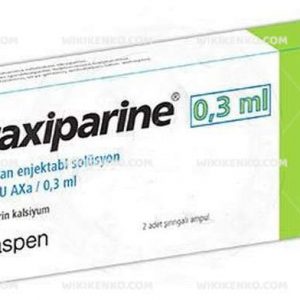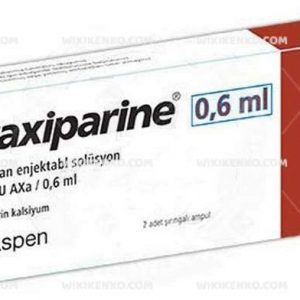Description
Fraxiparine Injection 3800 IU/0.4 mL is a prefilled syringe containing 0.4 mL of Nadroparin, a potent anticoagulant agent. It works by inhibiting the formation of blood clots and preventing the growth of existing ones, ensuring smooth blood flow throughout the body.
Mechanism of Action
Nadroparin, the active ingredient in Fraxiparine, belongs to the class of low molecular weight heparins (LMWHs). It exerts its anticoagulant effect by enhancing the activity of antithrombin III, a natural inhibitor of blood clotting factors. By binding to antithrombin III, Nadroparin potentiates its ability to inactivate clotting factors, thereby preventing the formation of harmful blood clots.
Indications and Uses
Fraxiparine Injection 3800 IU/0.4 mL is indicated for the following conditions:
Prevention of Venous Thromboembolism (VTE)
- Deep Vein Thrombosis (DVT) prophylaxis in patients undergoing orthopedic surgery, such as hip or knee replacement
- DVT prophylaxis in medical patients at risk of thromboembolic complications due to restricted mobility during acute illness
Treatment of Venous Thromboembolism (VTE)
- Treatment of acute DVT
- Treatment of acute pulmonary embolism (PE)
Unstable Angina and Myocardial Infarction
- Adjunctive treatment in patients with unstable angina or non-Q-wave myocardial infarction
Hemodialysis
- Prevention of clotting during hemodialysis sessions
Dosage and Administration
The dosage of Fraxiparine Injection 3800 IU/0.4 mL varies depending on the indication and individual patient factors, such as body weight, age, and renal function. It is essential to follow the prescribed dosage and administration guidelines provided by the healthcare professional.
Subcutaneous Injection
Fraxiparine is administered via subcutaneous injection, typically into the abdomen or thigh area. Healthcare professionals should provide proper instructions on self-injection techniques to patients who require long-term treatment.
Potential Side Effects
Like all medications, Fraxiparine Injection 3800 IU/0.4 mL may cause side effects in some patients. The most common side effects include:
- Injection site reactions (pain, bruising, redness)
- Bleeding (nosebleeds, gum bleeding, easy bruising)
- Hematoma formation at the injection site
- Elevated liver enzymes
Patients should be monitored closely for signs of bleeding or other adverse reactions, and any concerns should be promptly reported to their healthcare provider.
Contraindications and Precautions
Fraxiparine Injection 3800 IU/0.4 mL should be used with caution in patients with the following conditions:
- Active bleeding or increased risk of bleeding
- Recent surgery or trauma
- Severe renal impairment
- Uncontrolled hypertension
- Pregnancy and breastfeeding (consult with a healthcare professional)
Drug Interactions
Fraxiparine may interact with other medications, including anticoagulants, antiplatelet agents, and non-steroidal anti-inflammatory drugs (NSAIDs). Healthcare professionals should review the patient’s medication list and adjust the dosage or monitoring as necessary.
Monitoring and Follow-up
Regular monitoring of coagulation parameters, such as activated partial thromboplastin time (aPTT) or anti-Xa levels, may be necessary in certain patient populations or clinical situations. Follow-up visits and assessments should be scheduled to evaluate the effectiveness and safety of the treatment.
Table: Key Information about Fraxiparine Injection 3800 IU/0.4 mL
| Aspect | Details |
|---|---|
| Active Ingredient | Nadroparin |
| Dosage Form | Prefilled syringe (0.4 mL) |
| Strength | 3800 IU anti-Xa |
| Indications | Prevention and treatment of VTE, unstable angina, myocardial infarction, hemodialysis |
| Administration | Subcutaneous injection |
| Common Side Effects | Injection site reactions, bleeding, hematoma, elevated liver enzymes |
| Contraindications | Active bleeding, recent surgery/trauma, severe renal impairment |
| Monitoring | Coagulation parameters (aPTT, anti-Xa levels) |
Conclusion
Fraxiparine Injection 3800 IU/0.4 mL is a valuable anticoagulant medication used in various clinical settings for the prevention and treatment of thromboembolic disorders. Healthcare professionals should carefully evaluate the risks and benefits, monitor for potential side effects, and provide appropriate patient education to ensure safe and effective use of this medication.














Reviews
There are no reviews yet.